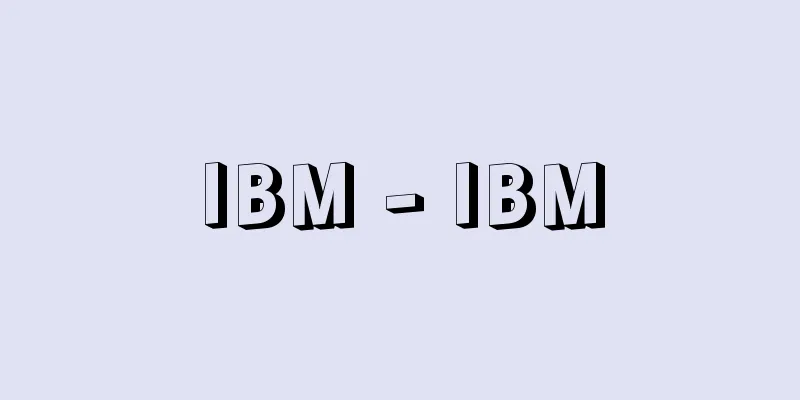IBM - IBM

|
The world's largest computer and information equipment manufacturer, based in the United States. A common name for International Business Machines Corp. IBM's roots go back to the Tabulating Machine Co., founded in 1896 by Hollerith, a statistical technician and German immigrant. At the time, America was industrializing and was accepting large numbers of immigrants as labor, making it difficult to compile statistics from census data. Hollerith realized the need to automate the processing of huge amounts of data, invented an automatic tabulating machine using a punch card system, and established the Tabulating Machine Co., which grew rapidly at the same time. In 1911, the company merged with two other companies, a time recorder company and an automatic weighing company, to become Computing-Tabulating Recording Co. (CTR). CTR, which was founded by a group of engineers, lacked management personnel and suffered from poor business performance from the beginning. So in 1914, Thomas J. Watson I, who had made a name for himself as a skilled salesman at NCR, which had grown rapidly with its cash registers, was appointed president, and the company continued to grow. In 1924, CTR changed its name to IBM. Watson grew IBM into a major corporation with his unique management philosophy, such as introducing a machine rental system and not firing employees even during the Great Depression. It was IBM's unrivaled technological capabilities that propelled the company to its current position. During the computer boom after World War II, IBM announced the System 7000, which used transistors, in 1960, the System 360, which used ICs (integrated circuits), in 1964, and the System 370, which used LSIs (large-scale integrated circuits), in 1970. The success of these computer developments allowed IBM to completely overtake competitors such as Remington Rand, and come to dominate the computer field (73.5% of the US market in 1965). However, in the 1980s, the company fell into a difficult position as Japanese companies caught up with them. The downsizing of computers caused a slump in the general-purpose computer market, and in 1993 IBM recorded an operating loss of $8.1 billion. As a result, the company carried out a full-scale restructuring, including major staff cuts. This restructuring transformed IBM into a company that made a lot of its money not only from hardware production, but also from software, information services, and other information technology networking. Business performance improved, and the company turned a profit in 1994. IBM's commercial computer operating system (OS) became used by many companies around the world, and sales of the company's network stations soared. The company has expanded into more than 120 countries around the world, and is also focusing on information networking in the world's emerging markets (emerging economic growth areas), including former socialist countries. Meanwhile, in order to enter the rapidly growing personal computer market in the 1980s, IBM announced the IBM PC in 1981, which used Intel's 16-bit CPU (Central Processing Unit) "8088", and in 1984 announced the IBM PC/AT, an improved version of the PC. In order to standardize the PC/AT, IBM adopted a strategy of actively disclosing the information that made up the hardware and enriching the peripheral devices and software developed by other companies. As a result, PC/AT compatible machines (IBM compatible machines), peripheral devices, and software products that were compatible with the PC/AT were released by various manufacturers. PC/AT compatible machines, which have compatible hardware, quickly became popular among consumers due to price competition, and became the de facto standard for hardware in the personal computer market. In Japan, DOS/V (Dosubui), an operating system that could handle Japanese, was announced in 1990, which contributed to the spread of PC/AT compatible machines. Sales in 2004 were $96.5 billion. In May 2005, IBM sold its PC business to the Chinese Lenovo Group, and since withdrawing from the PC business, the company has expanded its business to focus on systems and services for corporations. In Japan, Japan Watson Statistical Accounting Machine Co., Ltd. (now IBM Japan) was established in 1937 (Showa 12). [Shinjiro Hagiwara] [References] | | | | | | | | |Source: Shogakukan Encyclopedia Nipponica About Encyclopedia Nipponica Information | Legend |
|
アメリカの、世界最大規模のコンピュータ、情報機器メーカー。International Business Machines Corp.の通称。IBMのルーツは、1896年にドイツ移民の統計技官ホレリスが設立したタビュレーティング・マシン社Tabulating Machine Co.にさかのぼる。当時のアメリカは工業化の進展とともに労働力として大量の移民を受け入れ、国勢調査の集計データから統計を出す作業が難航していた。そこでホレリスは、膨大なデータの自動化に気づき、パンチカードシステムによる自動作表機を発明して、タビュレーティング・マシン社を設立と同時に急成長させた。その後同社は、1911年、タイムレコーダーの会社と自動秤(はかり)の会社の2社と合併して、コンピューティング・タビュレーティング・レコーディング社Computing-Tabulating Recording Co.(CTR)となった。技術者が集まってつくったCTRは経営能力のある人材が不足していたため、設立の当初から経営不振が続いた。そこで1914年、金銭登録機(キャッシュレジスター)で急成長したNCRの辣腕(らつわん)セールスマンとして名をあげたトーマス・J・ワトソン1世を社長に迎え、以後発展を遂げることとなる。1924年、CTRは社名をIBMに変更した。ワトソンは機械のレンタル制度を取り入れたり、大恐慌中にも従業員の解雇を行わないなど、独特の経営哲学でIBMを大企業に育て上げていった。 IBMを現在の地位にまで押し上げたのは、他社を寄せ付けないその技術力であった。第二次世界大戦後のコンピュータ・ブームのなかで、IBMは1960年にトランジスタを使用したシステム7000、1964年にIC(集積回路)を使用したシステム360、さらに1970年にLSI(大規模集積回路)を使用したシステム370を発表した。これらコンピュータ開発の成功によりIBMは、レミントン・ランド社など同業他社を完全に追い抜き、コンピュータの分野では圧倒的なシェア(1965年には全米市場の73.5%)を占めるに至った。 しかし、1980年代に入って、日本企業の追い上げなどにより、同社の経営は苦境に陥った。コンピュータのダウンサイジング(小型化)が、汎用(はんよう)コンピュータ市場の不振をもたらし、1993年には81億ドルもの経常赤字を記録した。そのため、同社は大幅な人員削減を含む本格的なリストラクチャリングを断行した。このリストラによってIBMは、ハードウェアの生産のみならずソフトウェア、情報サービスをはじめとする情報技術のネットワーク化から多くの収益をあげる企業に変身した。業績も改善し、1994年には黒字に転じた。IBMの商業用コンピュータ・オペレーティングシステム(OS)は、世界の多くの企業が使用するものとなり、同社のネットワーク・ステーションの売上げは急上昇した。同社は世界120か国以上に進出し、旧社会主義国をはじめとした世界のエマージング・マーケット(新興経済成長圏)での情報ネットワーク化にも力を入れている。 一方、IBMは1980年代に急成長していたパーソナルコンピュータ市場への進出のため、1981年にインテル社製の16ビットCPU(中央処理装置)「8088」を採用したIBM PCを発表し、1984年にはPCを発展させたIBM PC/ATを発表した。IBMはPC/ATを標準化させるため、ハードウェアを構成する情報を積極的に公開して、他社の開発による周辺機器やソフトウェアを充実させる戦略をとった。その結果、PC/ATと互換性をもつPC/AT互換機(IBM互換機)、周辺機器、ソフトウェア製品がさまざまなメーカーから発売された。ハードウェアに互換性のあるPC/AT互換機は、価格競争による低価格化もあって消費者の間に急速に普及して、パソコン市場におけるハードウェアの事実上の標準となった。日本でも、1990年に日本語が扱えるオペレーティングシステムのDOS/V(ドスブイ)が発表され、PC/AT互換機の普及に貢献した。2004年の売上高は965億ドル。2005年5月にパソコン事業を中国の聯想(レノボ)グループへ売却、パソコン事業撤退後は法人向けのシステムやサービスを中心とした事業展開を行っている。なお、日本では1937年(昭和12)に日本ワットソン統計会計機械株式会社(現日本アイ・ビー・エム)が設立されている。 [萩原伸次郎] [参照項目] | | | | | | | | |出典 小学館 日本大百科全書(ニッポニカ)日本大百科全書(ニッポニカ)について 情報 | 凡例 |
<<: Eichendorff - Joseph von Eichendorff
Recommend
Areole
...A great many species have differentiated. [for...
Kurozumikyo - Kurozumikyo
A Shinto religious organization. One of the thirt...
Trace fossil - trace fossil
A fossil is a record of the life of various ancie...
Cannstatt
…Many research, educational and cultural faciliti...
Newlands
British chemist. He entered the Royal College of ...
Stere (English spelling)
A unit of volume. Equivalent to 1 m3. A word meani...
Callinicos - Callinicos
...Population: about 35,000. Greek name: Nikēphor...
Mount Oyama (Kagoshima)
...Population: 7,456 (1995). The town is a terrac...
Botswana - Botswana (English spelling)
A landlocked country in southern Africa. Its offi...
Yanagibashi Shinshi - Ryukyo Shinshi
Essays written by Narushima Ryuhoku. The first vo...
Ibn Hani (English spelling)
… In the Maghreb and Al-Andalus, the mainstream o...
Nearshore area - Kinkaiikuiki
The term "maritime zone" refers to the a...
Sarta'ul (English spelling)
…A term used to refer to the inhabitants of oases...
artificial planet
...A general term for artificially launched satel...
Enrico Barone
Italian economist and military scholar. Born in N...









